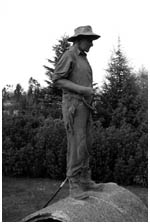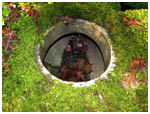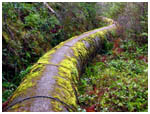 | | The Sooke Flowline Railway
In 1911 the resource-rich Sooke region on Vancouver Island, British Columbia, became the site of one of the greatest feats of engineering ever to take place on Vancouver Island. Victoria's expanding population needed water, and the City of Victoria Waterworks undertook to contract out the construction of a concrete pipeline to carry water from Sooke Lake to serve Victoria. Over the next few years, more than one contract was let, as different firms struggled to carry out the challenging undertaking.
| | 
This photo shows the main construction yard that built the pipes, located at Coopers Cove, where the inner Sooke Harbour meets today's Highway 14.
|
Men from a variety of backgrounds from all over the world came to the area to work on the project, joining in with men of the T'Sou-ke First Nation, Salish people whose skills were also utilized in the successful accomplishment of the monumental task.
When the flowline construction project was underway in Sooke between 1911 and 1915, it employed four hundred men. Destined to carry water via gravity flow from Sooke Lake to Humpback Reservoir at Goldstream from where it was distributed to the City of Victoria, the concrete pipe sections wound around the hillsides for 27 miles.
The main construction yard that built the pipes was located at Coopers Cove on the inner Sooke Harbour. Gravel and cement were barged in and off-loaded here. Cement mixers powered by steam boilers were used to manufacture the sections of concrete pipe that measured four feet in diameter and four feet in length. Fuel oil was barged in to fire the boilers. The plant and assembly line produced more than 35,000 pipe sections, each weighing a ton.
| | 
Once the four foot pipe sections came off the assembly line at the Coopers Cove plant, the curing process was assisted by workmen with water hoses.
|
Engineers surveyed and built a narrow gauge (36 inch} railway to carry the sections to either end of the route, Sooke Lake, and Humpback Reservoir. The sections were placed on bunk cars at the sea level production plant at Coopers Cove then winched up rails to the main upper level field camp.
This central field camp which housed many facilities, was established adjacent to the route that was surveyed along the hillsides for the temporary railway. At the railbed level the pipes were stored on their bunks on a siding, where they would be picked up by small steam locomotives and hauled into location at the far ends of the route.
Carried to the ends of the rail line by the locomotives, the rails were withdrawn and the pipes laid in the rail bed. Work proceeded from either end, withdrawing rail and laying pipe until the two branches connected in the middle, at the main field camp above Coopers Cove.
A project to the magnitude of the flowline construction offered employment for many trades and professions. From civil engineers of international background, local engineers with steam tickets, plant supervisors, carpenters, metal workers, loggers, to all manner of labouring jobs.
| | 
Three small steam locomotives were used for hauling the bunk cars carrying the heavy concrete pipes. Several steam engineers were employed operating the locomotives. The photo shows an engineer's transit alongside the pipes, which were 48 inches in exterior diameter and 42 inches interior diameter.
|
To house the men, a variety of camps were set up, providing bunkhouse and cookhouse. The main field camp was located at the upper level, above today's Ayum Road. The camp was alongside the company's narrow gauge railway and the siding tracks used for storing the concrete pipe sections awaiting hauling.
Besides the construction work available, young fellows in the community could find employment at jobs such as cook's helper in the camp kitchens. By all accounts, the crews were well-fed, with the company bringing out supplies from the city by barge as the community of Sooke in 1911 had no facilities for provisioning such large groups.
At some of the more remote field camps along the 27-mile route, a more primitive cooking method was sometimes employed by workmen of mid-European background. A bake-oven could be built from blasted fieldstone, a byproduct created through the construction of the railbed. Rocks were assembled in the formation of a miniature igloo, with a smoke hole at the top and a doorway to slide in the bread.
When the men built a fire within the stone cavern at night, the rocks accumulated heat. In the morning, the embers would be raked out, and bread dough that had been rising during the night was placed inside, baking slowly during the day. Imagine the welcoming smell of fresh baked bread when the workmen returned to their tent site in the evening!
| | 
This photograph at the main camp shows a siding where pipe sections could be stored for pickup by the steam locomotives and hauled to the far ends of the line for installation. Note the telephone pole, as communication lines were established along the three foot gauge railway.
|
The three-foot gauge railway that was built to carry the concrete pipe sections to the far points of the line for installation had several siding tracks that allowed for storage of the sections waiting to be hauled. A good deal of blasting of rock had to be undertaken in order to create a bed for the railway and subsequently for the pipe laid in its place.
Once the pipe sections were laid in place, the inverse and converse lips were connected and sealed with grout. Asbestos was universally used in many compounds in those years and this project was no exception, as the grouting mixture had significant asbestos content.
Once the flowline was in use, and interesting feature of its maintenance over the years was the need to clean the interior of ingrown roots and other matter. A special flat cart was built and a worker was required to lie prone atop it, and journey through the pipe interior to remove unwanted materials.
Inspection of the flowline itself was carried out weekly by a watchman who pedaled a specially built tricycle along the route, checking for trees falling across the pipes or leaks which would have hampered the flow of water serving Victoria. Leaks required banding with copper over a rubber gasket to help retain the water.
| | 
Shown here is one of the most extensive temporary railway trestles with a train carrying pipes westward. In the lower background previously installed pipe is seen laid on a permanent trestle of concrete.
|
The special tricycles with cambered wheels were constructed by Sooke blacksmith Lyall Shields, and over the years the devices were operated by a number of men.
Along the pipeline route, the company established a series of field camps. While the major camp was up on the hill above the Coopers Cove production yard, there was also a significant camp in the Mary Vine Creek area, in today's Sooke Potholes Regional Park.
Wives of company officials and engineers sometimes accompanied their husbands, camping in tent/cabins at field sites. It's hard to imagine how they managed, camping in rustic conditions, to look as smart as they seem here in the attire worn during the early years of the 20th century.
In an account from the wife of a British engineer who lived with her husband at a remote cabin in 1914-1915 she remarks how much she enjoyed her time in the woods. Her husband was tasked with the responsibilities of an
| | 
This fine view shows the pipeline route carved out of the hillside while workmen use a steel tripod and chain block to place pipe sections on the right of way left behind when the temporary railway was pulled up. Note the railway ties thrown aside for the laying of the pipe sections.
|
She cooked on a wood stove, and buying food at the company's camp store, provided fine meals, often steak, for her husband hungry from a day on the pipeline. Occasional trout caught in the creek added variety to their diet.
They used water from a nearby stream for clothes washing. She walked, exploring the vast forests, or when she was at home at the cabin enjoyed making a cup of tea for passing visitors such as game-wardens, vagabonds, loggers, and prospectors.
As the pipeline construction progressed and it was time to move camp, they loaded up their few belongings and rebuilt at the next site, always convenient to a flowing stream.
Another aspect of the flowline construction involved felling trees and saw milling. Because of the many ravines and gullies within the Sooke Lake to Goldstream system, the engineers needed to design a route that included a number of trestles in order for the railway line to carry the pipe sections to the far ends.
| | 
Along the pipeline, manholes or air vents were established every half mile. This allowed access into the pipe for periodic cleaning, and provided air circulation. This photo shows a pipeline manhole today.
|
To clear the right of way and build the trestles, woodsmen employed by the company felled Douglas-fir trees along the way. Some were utilized as round poles, while a portable sawmill was employed to saw larger trees into timbers for bridge stringers and ties, and also for dam and camp construction. "instrument man" and later worked as a "concrete inspector".
Over the years, experience showed that stress occurred at the siphons, as they were called, that carried the waterflow to the lower level trestles, causing excessive leakage. During the 1930s concrete siphons were replaced with wood stave pipe.
Once the water reached the Humpback Reservoir at Goldstream, it was stored and sent via a distribution system serving Greater Victoria.
Since 1971 water has flowed to Victoria via the six-and-a-half mile Kapoor Tunnel from the Sooke Reservoir to Japan Gulch so the importance of the flowline has declined. Sooke's water still flows through the concrete pipeline as far as Charters Creek.
| | 
A remaining portion of the Sooke Flowline as it exists today.
|
Water designed for Sooke was originally shipped from the concrete flowline to a "spillhouse" above Dixon Road for distribution into Sooke via wood stave pipe. Since 1992 Sooke's water has been supplied via a 16 inch interconnection from the flowline to a supply main below Charters Dam.
In the period between 1911 and 1915 when this mammoth undertaking took place, hundreds of workmen from varied ethnic backgrounds were attracted to find work on the project. Some of these men settled into the area and became lifelong citizens of Sooke, while others moved on, following the availability of work.
Some of the men employed on the flowline project were able to move on to the construction of the Canadian Northern Pacific Railway, from Victoria to the Cowichan Valley. This railway, renamed the Canadian National Railway, was built soon after the flowline, and transported lumber from mills as far away as Cowichan Lake. Poles and pilings were also carried into the Victoria area for many years.
The developing logging industry also offered employment, while others who had arrived because of the flowline settled in the community, some farming, some going into business.
Many local residents have long-held fond memories of the pipeline, and though access to the Water District's right of way is restricted for safety reasons, adventurous hikers have taken the liberty of enjoying the route.
Associated Web Sites
Sooke Region Museum
Capital Regional District Water Services

|
|
| |